17 Actors Who Transformed Into the Real People They Portrayed
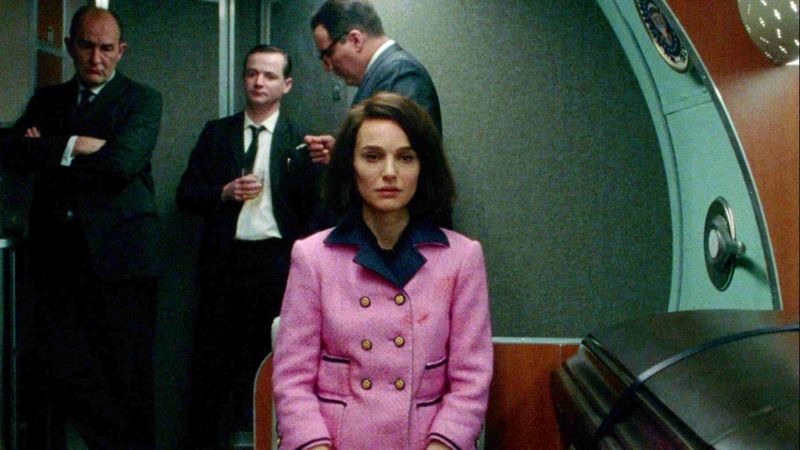
Hollywood has always been fascinated with bringing real-life stories to the big screen. When actors take on the challenge of portraying actual historical figures, they often go to extraordinary lengths to capture their essence. From physical transformations to mastering unique mannerisms, these performers don’t just play their roles—they become them. The results are performances so authentic that the line between actor and subject seems to vanish completely.
Daniel Day-Lewis as Abraham Lincoln (Lincoln, 2012)
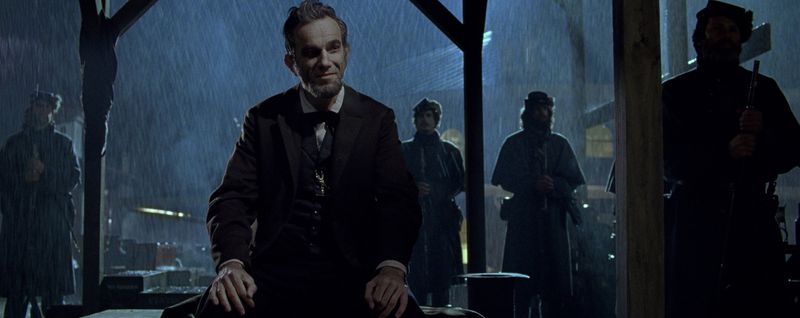
The method acting approach taken by Day-Lewis for this presidential portrayal became instantly legendary in Hollywood circles. For months before filming began, he spoke using Lincoln’s high-pitched voice, even when cameras weren’t rolling.
Crew members received text messages signed ‘A’ instead of Daniel. Standing at 6’4″, Day-Lewis matched Lincoln’s towering height naturally, but his transformation went far beyond physical resemblance. He studied the 16th president’s walking style and adopted his stooped posture, giving audiences the eerie feeling they were watching the actual historical figure.
His dedication paid off with a third Oscar win, cementing his reputation as one of cinema’s most committed performers. The transformation was so complete that director Steven Spielberg began addressing him as “Mr. President” on set.
Rami Malek as Freddie Mercury (Bohemian Rhapsody, 2018)
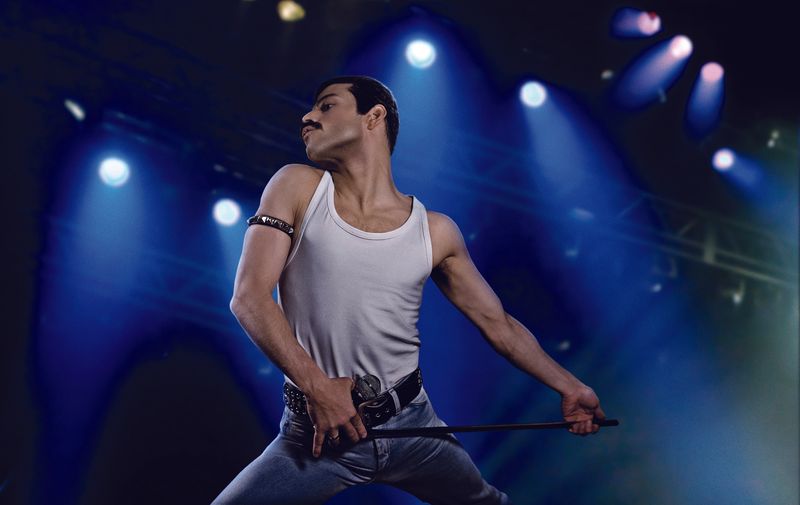
Behind the iconic mustache and flamboyant stage presence was months of grueling preparation that transformed Malek into Queen’s legendary frontman. Working with movement coaches daily, he studied Mercury’s every gesture and stage move, ultimately creating an uncanny physical resemblance that stunned audiences worldwide.
The performance challenge extended beyond appearance—Malek wore custom prosthetic teeth to recreate Mercury’s distinctive overbite. These weren’t just for looks; he began wearing them months before filming to adapt his speech patterns accordingly.
For concert scenes, the film blended Malek’s voice with Mercury’s original recordings and Canadian singer Marc Martel. The seamless vocal performance, combined with precise physical mimicry of Mercury’s electrifying stage presence, created movie magic that earned Malek his first Academy Award.
Meryl Streep as Margaret Thatcher (The Iron Lady, 2011)
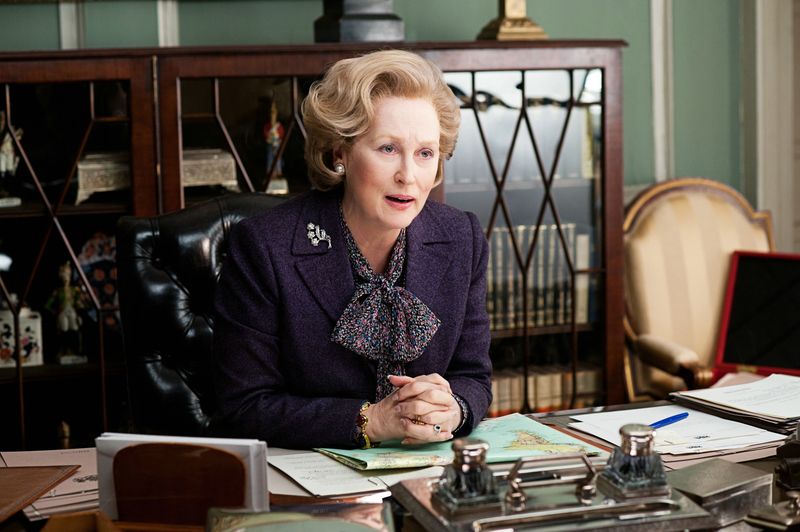
Achieving the perfect balance between physical resemblance and capturing the essence of Britain’s first female prime minister showcased Streep’s legendary versatility. Hours in the makeup chair transformed her appearance, but the real magic happened when she adopted Thatcher’s distinctive speaking style and commanding presence.
Throughout filming, Streep wore specially weighted shoes to mimic Thatcher’s deliberate way of walking. This attention to detail extended to mastering the Prime Minister’s increasingly deeper voice over the years—a conscious change Thatcher had made to command respect in male-dominated politics.
The performance spanned decades of Thatcher’s life, requiring Streep to portray both the powerful political figure at her peak and the elderly woman suffering from dementia. Critics praised how she humanized a polarizing historical figure while maintaining the steely resolve that earned Thatcher her nickname.
Jamie Foxx as Ray Charles (Ray, 2004)
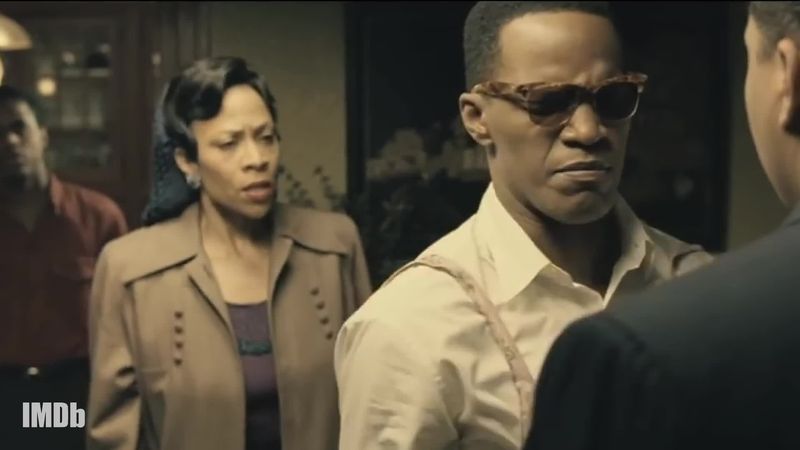
The physical commitment to portraying the legendary blind musician went far beyond learning to play piano like Charles. During filming, Foxx wore prosthetic eyelids sealed shut, experiencing genuine blindness for up to 14 hours daily on set.
This immersive approach helped him authentically navigate scenes without relying on sight. Music flowed naturally for Foxx, who began piano training at age five. Though the film used Charles’ original recordings, Foxx performed all piano playing scenes himself after studying with Charles’ actual piano coaches. The two men even played piano together before filming began.
Weight loss completed the transformation, with Foxx shedding 30 pounds to match Charles’ physique. The musician himself approved of Foxx’s portrayal shortly before passing away, noting how accurately the actor had captured his mannerisms and spirit—praise that preceded Foxx’s well-deserved Oscar win.
Gary Oldman as Winston Churchill (Darkest Hour, 2017)
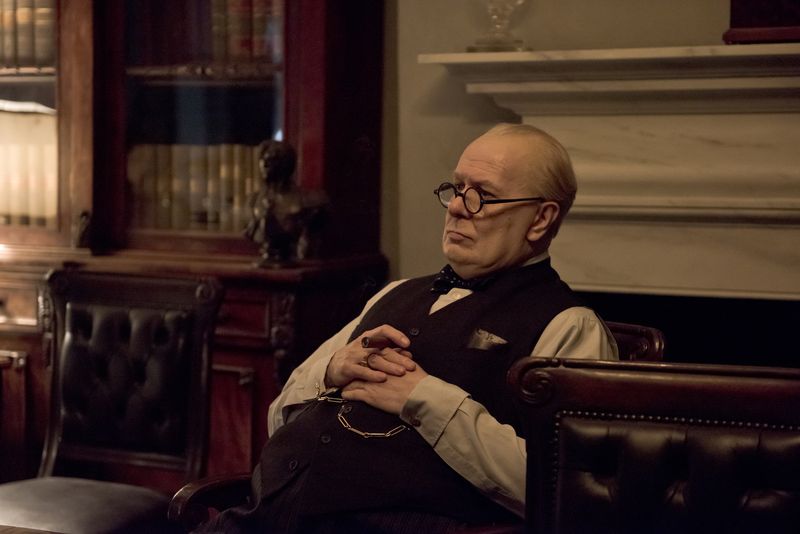
The dramatic physical transformation required nearly four hours of makeup application daily, with Oldman barely recognizable beneath prosthetics that added Churchill’s signature jowls and rounded physique.
Despite being naturally thin, Oldman convincingly embodied the heavier statesman without wearing a fat suit, relying instead on facial prosthetics and posture. Vocal training became a crucial component, with Oldman practicing Churchill’s distinctive speaking patterns for months. According to the actor, he smoked about 12 cigars daily during filming—roughly $20,000 worth of Churchill’s favorite Cuban cigars—resulting in nicotine poisoning that required medical attention.
Between takes, Oldman remained in character, asking crew members to address him as “Sir Winston.” His meticulous research included listening to recordings of Churchill’s speeches repeatedly while sleeping to internalize the rhythms and inflections that made the wartime leader’s oratory so powerful.
Austin Butler as Elvis Presley (Elvis, 2022)
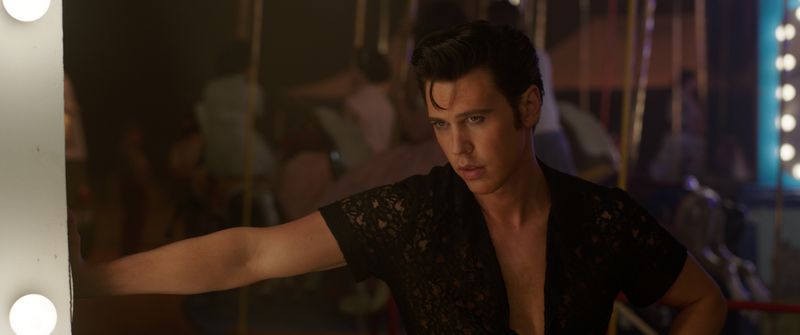
The voice transformation became so ingrained that Butler couldn’t shake Elvis’s distinctive Southern drawl for nearly two years after filming wrapped. His immersive preparation included isolating himself in a room plastered with Elvis images and listening exclusively to Presley’s music and interviews for months before cameras rolled.
Physical training transformed Butler’s body to match Elvis across different life stages. For early career scenes, he maintained an extremely lean physique through strict diet and exercise, later gaining weight to portray the star’s later years. Makeup and prosthetics helped complete the aging process, but the physical resemblance was largely Butler’s natural achievement.
Learning Presley’s specific hip movements and stage mannerisms required daily dance training. Butler performed all the early career concert scenes with his own voice, only blending with Presley’s actual recordings for later-era performances—a vocal commitment that impressed even Elvis’s surviving family members.
Cate Blanchett as Katharine Hepburn (The Aviator, 2004)
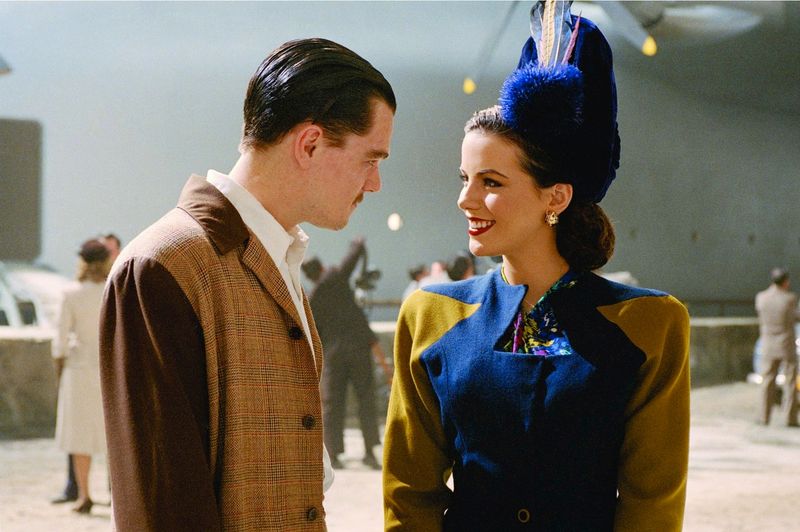
The technical precision behind this portrayal showcased Blanchett’s remarkable ability to embody another performer’s essence completely. Rather than simply mimicking Hepburn, she captured the actress’s unique physicality—the long-limbed, athletic movements and characteristic head tilt that made Hepburn instantly recognizable to audiences.
Mastering Hepburn’s distinctive accent proved particularly challenging. The classic Hollywood star spoke with what film historians call a “Mid-Atlantic” accent—neither fully American nor British. Blanchett studied countless interviews and films to perfect this unusual speech pattern that was once standard among society’s elite. For scenes depicting Hepburn’s infamous golf skills, Blanchett trained extensively with professional coaches.
Though naturally right-handed, she learned to play left-handed like Hepburn. This dedication to authenticity earned Blanchett her first Academy Award and cemented her reputation as one of her generation’s most versatile performers.
Robert De Niro as Jake LaMotta (Raging Bull, 1980)
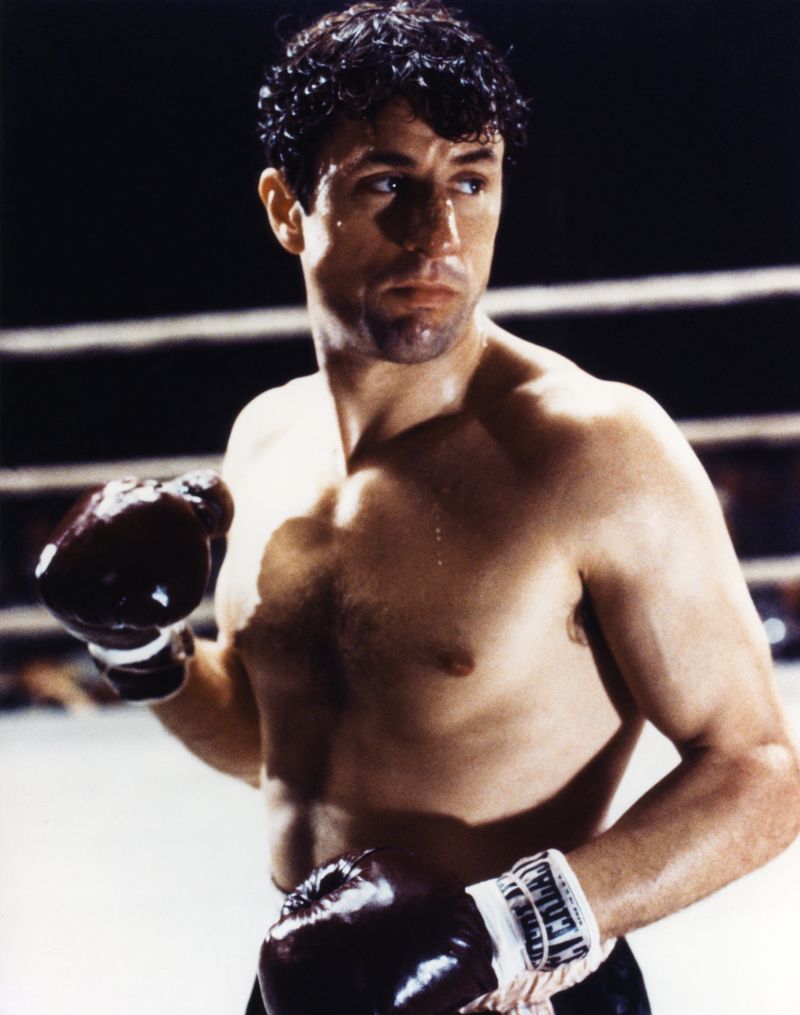
The shocking physical transformation remains one of cinema’s most legendary examples of method acting commitment. For early scenes portraying LaMotta as a lean middleweight boxer, De Niro trained extensively with the real Jake LaMotta, developing a fighter’s physique and skills impressive enough for the former champion to rank him in the top 20 middleweights of the time.
Production then halted for four months while De Niro gained an unprecedented 60 pounds to portray the older, heavier LaMotta. This dramatic weight gain affected his health significantly, with the actor later recalling how even walking became difficult during this phase of filming.
Beyond physical appearance, De Niro absorbed LaMotta’s mannerisms and distinctive speech patterns through countless hours spent with the former boxer. The transformation was so complete that LaMotta himself was stunned, reportedly asking director Martin Scorsese, “How did you find a guy who fights so much like me?”
Charlize Theron as Aileen Wuornos (Monster, 2003)
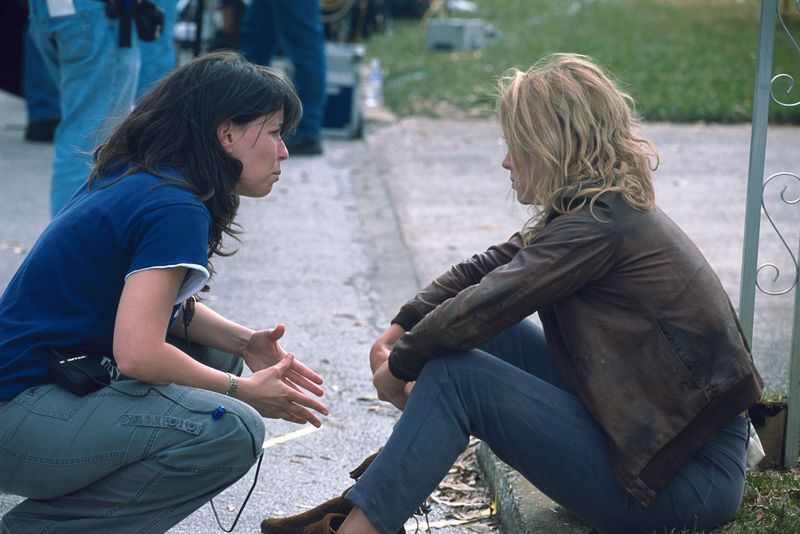
The radical physical alteration from Hollywood beauty to hardened serial killer remains one of cinema’s most startling transformations. Beyond gaining 30 pounds, Theron wore prosthetic teeth, colored contacts, and makeup that created Wuornos’s weather-beaten skin.
Her naturally arched eyebrows were covered with makeup and redrawn to match Wuornos’s straighter brows. Body language became crucial to the portrayal, with Theron studying countless hours of interview footage to capture Wuornos’s distinctive movements. She mastered the convicted killer’s awkward gait, tense shoulders, and specific way of speaking through clenched teeth—physical manifestations of a lifetime of abuse and hardship.
Throughout filming, Theron maintained the character’s appearance and mannerisms even between takes. The transformation proved so complete that the film’s crew often found it jarring when she occasionally broke character, revealing glimpses of her natural voice and personality beneath the haunting portrayal that would win her an Academy Award.
Will Smith as Richard Williams (King Richard, 2021)
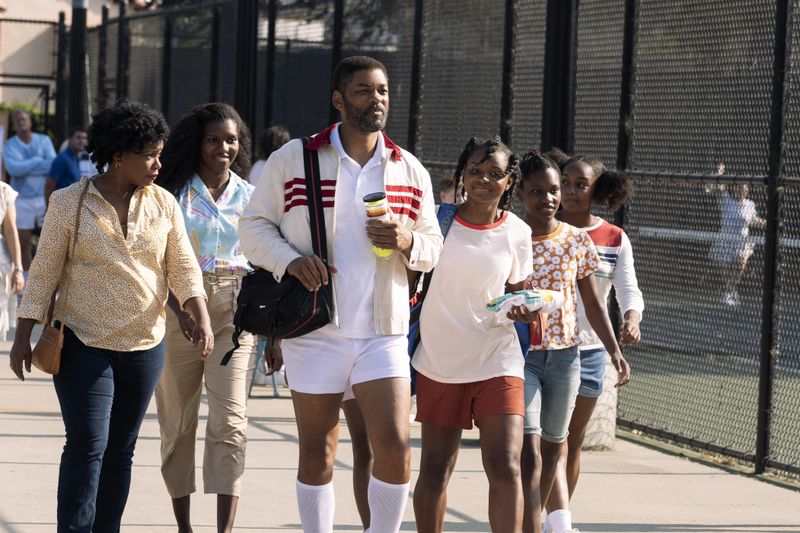
The subtle physical changes Smith underwent to portray the father of tennis legends Venus and Serena Williams demonstrated remarkable attention to detail. Makeup artists gave him Williams’s slightly lighter complexion and receding hairline, while Smith adopted a hunched posture to match the tennis coach’s distinctive stance developed from years of physical labor.
Mastering Williams’s Louisiana accent required months of dialect coaching. Smith worked extensively with a movement coach to capture Williams’s specific walking style—a slightly bowlegged gait resulting from a childhood accident. These nuanced physical details helped create an authentic portrayal that went far beyond simple mimicry.
Throughout filming, Smith carried a notebook filled with Richard Williams’s actual philosophies and teaching methods. This immersive approach helped him internalize Williams’s determination and unconventional coaching style. The Williams family praised Smith’s portrayal for capturing Richard’s complex personality—both his stubborn drive and the deep love for his daughters that motivated his controversial methods.
Brendan Fraser as James Whale (Gods and Monsters, 1998)

The subtle transformation into the openly gay Frankenstein director showcased Fraser’s remarkable range beyond his action-hero roles. Rather than relying heavily on makeup, Fraser captured Whale’s essence through precise mannerisms and speech patterns, studying extensive footage of the director to master his distinctive upper-class British accent and elegant gestures.
Physical preparation involved adopting Whale’s ramrod-straight posture and deliberate movements. Fraser worked with movement coaches to embody the film director’s specific way of carrying himself—a product of both Whale’s military background and his conscious self-presentation as a sophisticated artist in Hollywood’s golden age.
For scenes depicting Whale’s stroke-impaired condition, Fraser consulted with medical experts about the physical effects of stroke. The performance showed remarkable restraint, avoiding caricature while honestly portraying both Whale’s physical decline and his undiminished artistic spirit. Critics particularly praised how Fraser captured the director’s complex mix of vulnerability and dignity in his final days.
Natalie Portman as Jackie Kennedy (Jackie, 2016)
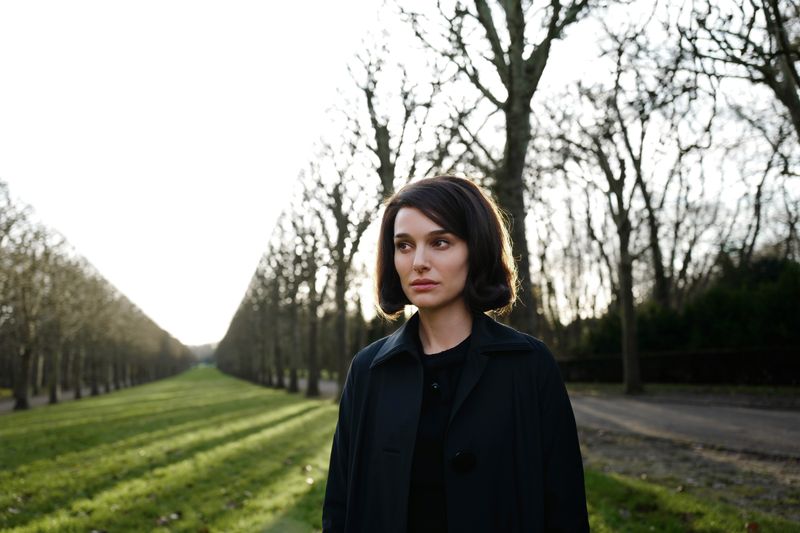
The vocal transformation required for this role proved particularly challenging, with Portman mastering Jackie’s unique speaking style—a breathy, almost whispery voice with precise diction and unusual cadence. Hours of studying interviews and working with dialect coaches helped her capture this distinctive speech pattern that was instantly recognizable to Americans who lived through the Kennedy era.
Physically, Portman underwent a subtle but effective transformation with a specific wig cut to match Jackie’s iconic bouffant hairstyle. Costume designers meticulously recreated the First Lady’s legendary wardrobe, including the pink Chanel suit worn during the assassination. Portman’s naturally petite frame matched Jackie’s physical stature.
Beyond appearance, Portman captured Jackie’s specific way of moving—her graceful posture and deliberately measured gestures that reflected her finishing school background. The performance particularly shone in recreating the famous White House tour television special, where Portman’s embodiment of Jackie’s carefully constructed public persona revealed the calculated nature behind the First Lady’s seemingly effortless elegance.
Anthony Hopkins as Alfred Hitchcock (Hitchcock, 2012)
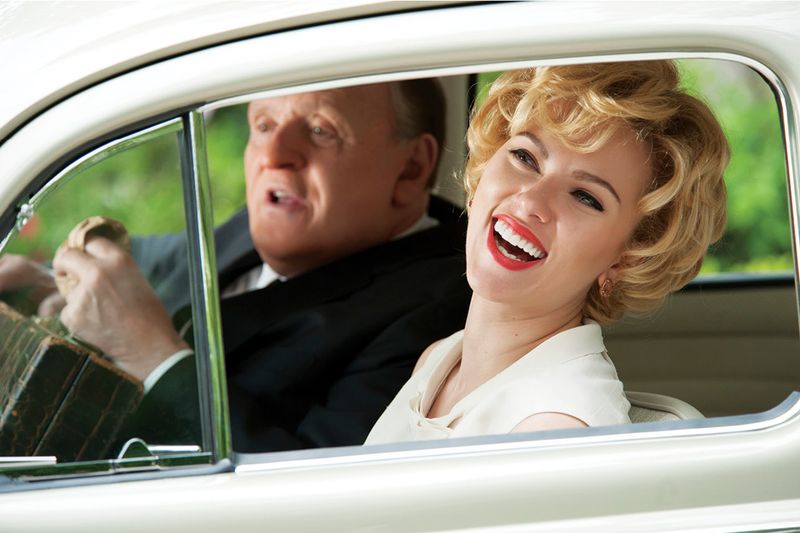
The extensive prosthetic work transformed Hopkins into the rotund Master of Suspense, requiring nearly three hours of daily makeup application. A full-body silicone suit gave Hopkins Hitchcock’s distinctive physique, while facial prosthetics created the director’s jowls and famous profile. The actor’s eyes remained his only visible natural feature.
Capturing Hitchcock’s unique vocal cadence became Hopkins’ primary focus during preparation. The director’s slow, measured speech with precise enunciation and distinctive pauses created his unmistakable presenting style familiar to fans of his television show. Hopkins studied hours of footage to master these speech patterns.
Movement coaching helped Hopkins adopt Hitchcock’s surprisingly light-footed walk and specific hand gestures. The transformation extended to learning the director’s eating habits—Hopkins practiced Hitchcock’s precise, almost dainty way of consuming food that contrasted with his large frame. These details helped create a portrayal that went beyond physical resemblance to capture Hitchcock’s complex personality.
Renée Zellweger as Judy Garland (Judy, 2019)
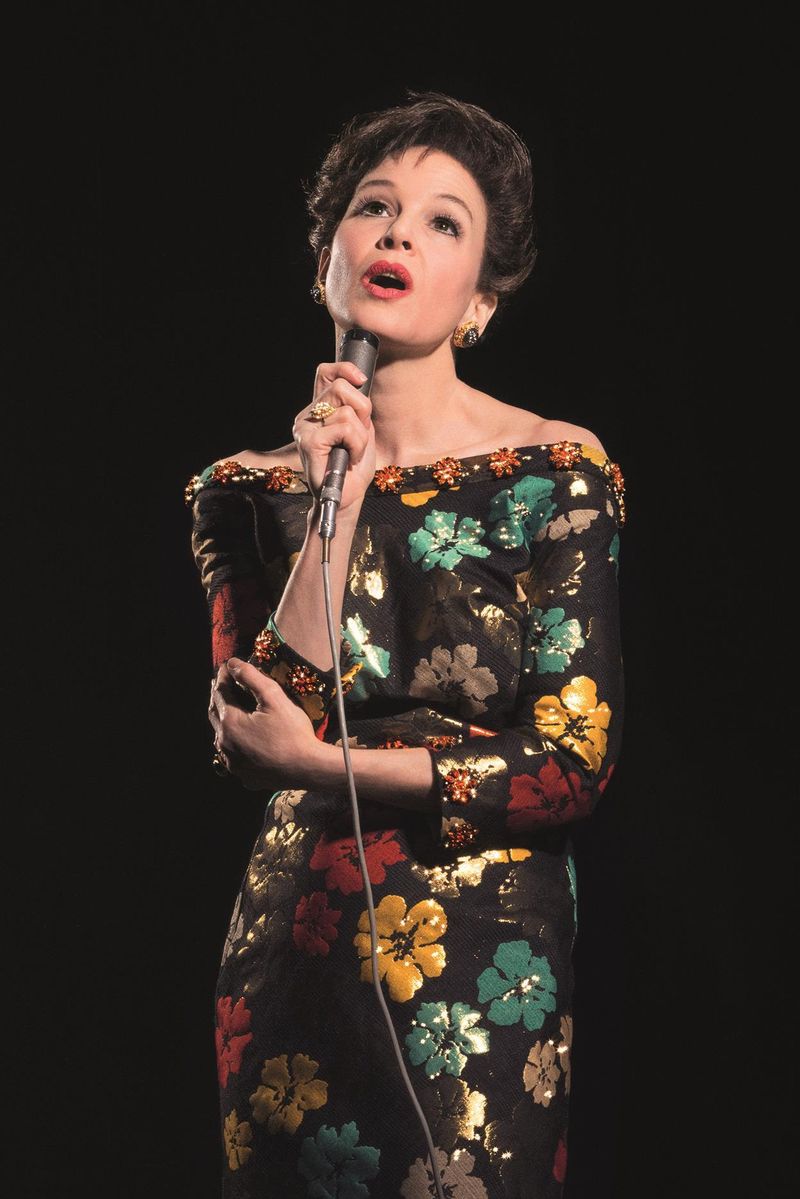
The vocal performance stunned audiences as Zellweger performed all of Garland’s songs herself rather than relying on recordings. Working with vocal coaches for a full year before filming, she developed the specific qualities of Garland’s later singing voice—powerful but fragile, showing the effects of years of substance abuse and strain.
Physically, the transformation was subtle but effective. Rather than using heavy prosthetics, makeup artists gave Zellweger Garland’s distinctive arched eyebrows and applied prosthetic teeth to recreate her smile. Contact lenses transformed Zellweger’s naturally blue eyes to Garland’s famous deep brown. Movement became key to capturing Garland’s essence during her final London performances.
Zellweger studied countless hours of footage to master the star’s specific hand gestures, slightly hunched posture, and nervous mannerisms that reflected her declining health and addiction struggles. The performance captured both Garland’s legendary stage presence and her painful vulnerability, earning Zellweger her second Academy Award.
Denzel Washington as Malcolm X (Malcolm X, 1992)
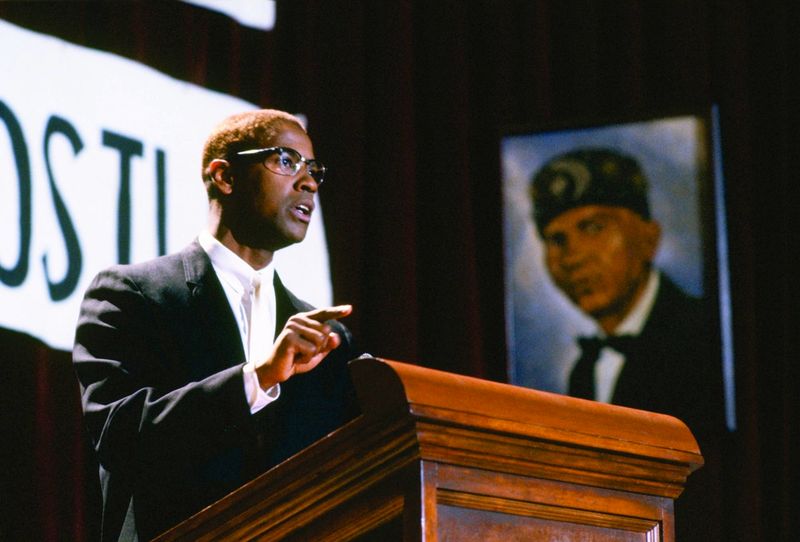
The physical resemblance Washington achieved went far beyond the iconic glasses and reddish hair. He lost weight to match Malcolm X’s lean frame and studied hours of footage to master the civil rights leader’s distinctive hand gestures and powerful speaking style—particularly his habit of pointing forcefully to emphasize key points during speeches.
Preparation for the role became all-consuming, with Washington immersing himself in Malcolm X’s writings and speeches. He temporarily stopped eating pork and drinking alcohol in accordance with Nation of Islam practices. The actor even visited jails where Malcolm had been incarcerated to better understand that formative period in the leader’s life. Throughout filming, Washington maintained Malcolm’s precise diction and formal speech patterns even between takes.
Director Spike Lee noted that Washington seemed to channel Malcolm’s spirit during key speech scenes, creating moments where crew members forgot they were watching an actor rather than historical footage. The transformation captured both Malcolm’s fiery public persona and his more contemplative private moments.
Heath Ledger as Ned Kelly (Ned Kelly, 2003)
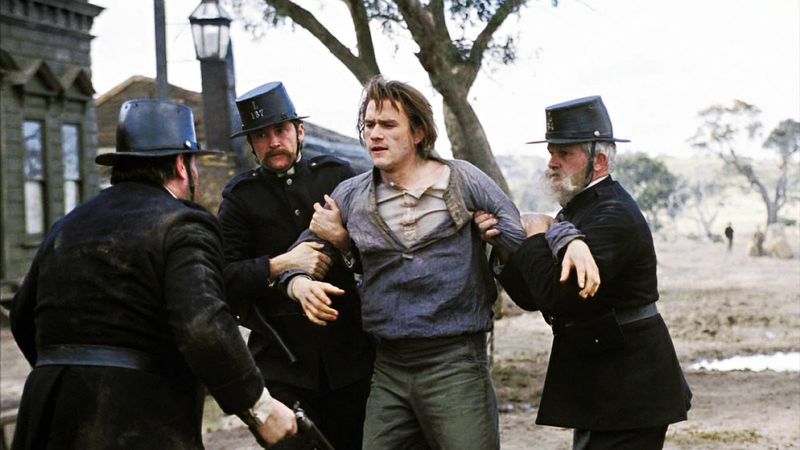
The striking physical transformation into Australia’s legendary bushranger centered around Kelly’s famous beard. Ledger grew a massive, authentic beard for months before filming began, refusing to use fake facial hair to ensure authenticity. The beard became so iconic that it essentially created its own character in the film. Adopting Kelly’s distinctive Irish-Australian accent required extensive dialect coaching.
Ledger worked with historians to understand the specific regional accent of Irish immigrants in 19th-century Victoria, Australia. This attention to linguistic detail helped ground the performance in historical accuracy. For horseback scenes, Ledger trained extensively with period-appropriate riding techniques and weapons handling.
He studied historical accounts of Kelly’s movements and fighting style to accurately portray the outlaw’s legendary physical prowess. The transformation captured both Kelly’s intimidating presence and the vulnerability behind his rebellion, presenting a nuanced view of a figure often reduced to simple folk hero or villain in Australian history.
Ben Kingsley as Mahatma Gandhi (Gandhi, 1982)
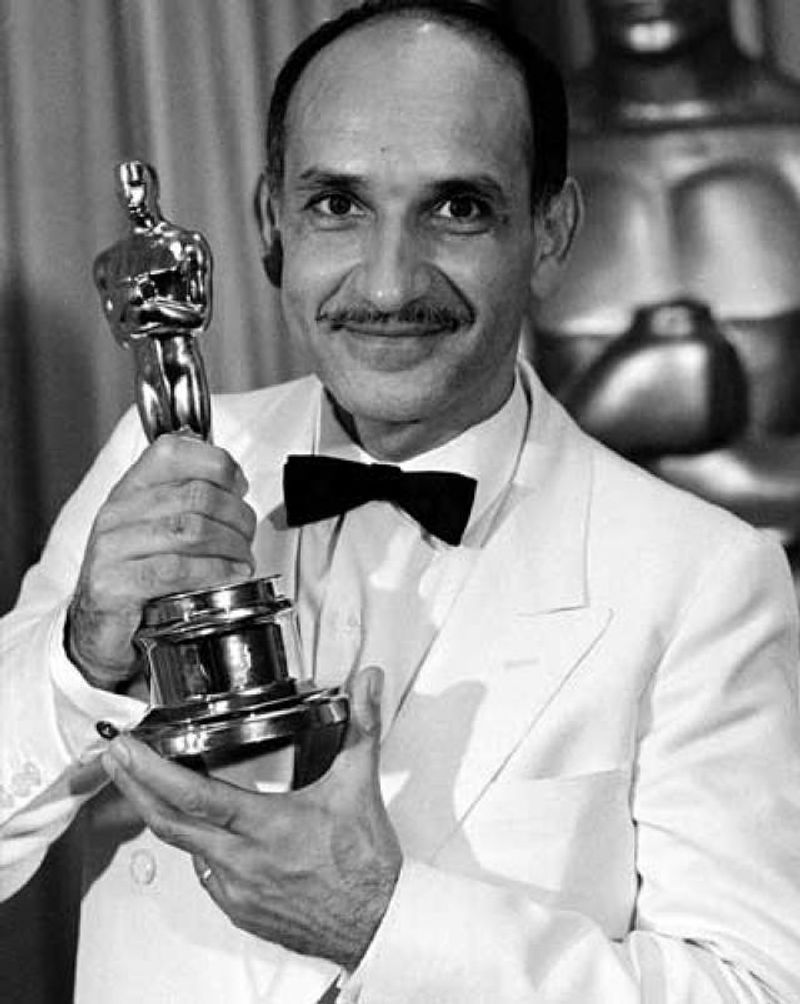
The remarkable physical commitment began with Kingsley losing 20 pounds from his already lean frame to match Gandhi’s ascetic appearance. Half-Indian himself, Kingsley shaved his head daily and spent hours in the sun to darken his skin tone naturally rather than relying on makeup, creating an uncanny resemblance to the Indian leader.
Learning to spin cotton on a traditional charkha became crucial preparation, as this activity was central to Gandhi’s philosophy of self-reliance. Kingsley practiced for months until the motion became second nature, allowing him to perform spinning scenes while delivering dialogue without appearing to concentrate on the task.
Throughout the extensive nine-month shoot, Kingsley maintained Gandhi’s vegetarian diet and slept on a thin mat on the floor rather than a bed. He mastered Gandhi’s distinctive high-pitched voice and specific walking style—a brisk pace with short steps using a walking stick. The transformation was so complete that Indian extras who had known the real Gandhi were moved to tears upon seeing Kingsley in character.

Comments
Loading…